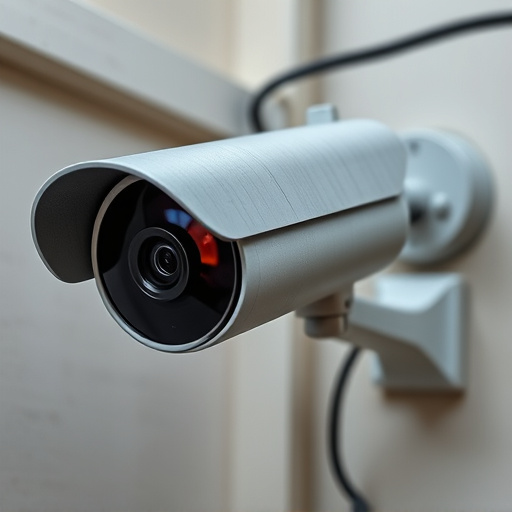Dummy surveillance cameras, placed according to a Fake Security Camera Angle Guide, act as powerful visual deterrents against crime by simulating active monitoring, altering intruder behavior, and reducing break-ins. Strategic positioning at high angles covers blind spots, enhances night visibility through lighting considerations, and navigates obstructions for comprehensive surveillance. Effective placement near entry points and realistic appearance maximize their deterrent effect, making them an ideal security measure for homes and businesses in today's digital era.
“Enhance your home or business security with the strategic placement of dummy surveillance cameras. This guide delves into the art of utilizing fake security cameras as a powerful visual deterrent. From understanding their purpose to navigating key factors like angle and positioning, we equip you with insights to make informed decisions.
Learn how to avoid common mistakes when setting up these devices, ensuring an effective and realistic security setup. Uncover the ‘Fake Security Camera Angle Guide’ to maximize their impact and deter potential threats.”
- Understanding the Purpose of Dummy Surveillance Cameras
- Key Factors to Consider for Optimal Camera Placement
- Creating an Effective Visual Deterrent with Angle and Positioning
- Common Mistakes to Avoid in Setting Up Fake Security Cameras
Understanding the Purpose of Dummy Surveillance Cameras
Dummy surveillance cameras, also known as fake security cameras, serve a unique purpose in enhancing physical security and deterring potential criminals. They operate as a powerful visual deterrent, providing a false sense of surveillance that can significantly alter an individual’s or group’s behavior. By strategically placing these realistic-looking imitators, property owners and businesses can create the illusion of a well-protected environment, thereby discouraging unauthorized entry or suspicious activities.
Understanding the correct placement of dummy cameras is essential for maximizing their effectiveness as a Fake Security Camera Angle Guide. These devices are not merely decorative; they should be positioned in areas visible to potential intruders, mimicking real surveillance systems. Whether it’s on walls, ceilings, or even mounted on poles, the goal is to create an impression that actual cameras are actively monitoring the premises. This strategic deception can act as a powerful deterrent and may even lead to a reduction in break-ins or suspicious behavior.
Key Factors to Consider for Optimal Camera Placement
When placing dummy surveillance cameras, or fake security cameras, it’s crucial to consider several factors that mirror those for real camera systems. The fake security camera angle guide should start with understanding your target area. Whether it’s a store front, office building, or residential property, knowing the fields of view you want to monitor is essential. Positioning your dummy cameras at strategic angles allows you to cover blind spots and maximize visual surveillance, acting as a powerful deterrent for potential intruders.
Lighting plays a significant role in effective camera placement. Ensure the area around the fake security cameras has adequate illumination to capture clear images day or night. Reflectors or strategically placed lighting fixtures can enhance this effect. Additionally, consider the environment and obstructions like trees, signs, or buildings that might obstruct the camera’s view. Smart positioning can help overcome these challenges, ensuring optimal visibility and a comprehensive fake security camera angle guide.
Creating an Effective Visual Deterrent with Angle and Positioning
A dummy surveillance camera’s effectiveness as a visual deterrent hinges on its angle and positioning. Strategically placing your fake security cameras can significantly impact how potential intruders perceive your property’s security measures. When it comes to the Fake Security Camera Angle Guide, the general rule is to place them at high, visible angles that cover key areas. This mimics the line of sight a real camera would have, creating an illusion of constant surveillance.
Imagine positioning your dummy cameras above eye level, pointing downwards, or even slightly outwards. This angle discourages unauthorized entry because it conveys that any attempt to enter would be clearly visible and recorded. Positioning them near windows, doors, or common points of access further reinforces this deterrence, as potential intruders might pause to consider the consequences of their actions.
Common Mistakes to Avoid in Setting Up Fake Security Cameras
Setting up dummy surveillance cameras, often referred to as fake security cameras, can be a great way to deter potential criminals and enhance home or business security. However, many people make common mistakes that reduce their effectiveness. One of the most crucial aspects to avoid is improper placement. Cameras should be positioned at angles that cover key areas without creating obvious blind spots. For instance, placing them too high or too low can result in poor image quality or missed footage.
Another mistake is not utilizing realistic features. Fake security cameras must look authentic; otherwise, their deterrent effect diminishes. Avoid using cheap, obviously artificial products with visible flaws. Instead, opt for high-quality replicas that mimic real cameras closely, including the lens and light indicators. Additionally, ensure the camera’s view isn’t obstructed by nearby objects or decorations, which could prevent it from capturing clear images.
Dummy surveillance cameras serve as powerful visual deterrents, but their effectiveness hinges on strategic placement. By understanding the key factors like angle and positioning, you can create an authentic security presence that discourages potential intruders. Remember, it’s crucial to avoid common mistakes like poor visibility or inconsistent placement. Utilize this Fake Security Camera Angle Guide to ensure your dummy cameras deter crime as intended, enhancing your home or business’s overall security without breaking the bank on real surveillance systems.
